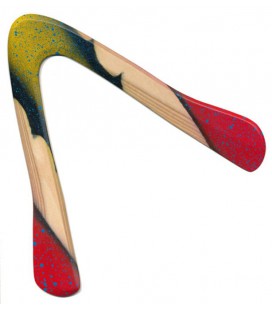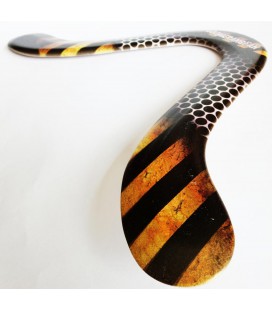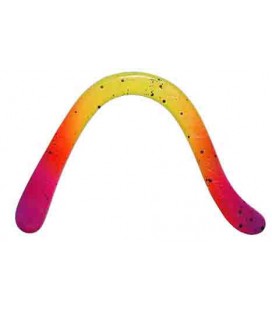Panier 0
0 item(s) - 0,00 € Pas de produit
To be determined Frais de port
0,00 € Total
Quantité
Total
Produit ajouter avec succès
Il y a 0 éléments dans le panier Il y a 0 éléments dans le panier
Total
Catalogue
Boomerang bipale
Quoi de plus beau qu’un vol de boomerang bipale sur un coucher de soleil.
Le boomerang bipale représente le boomerang originel australien.
Le boomerang australien en forme de « banane » a considérablement évolué pour devenir ultra-performant.
Un boomerang bipale est un boomerang composé de 2 pales souvent appelées « branches » par les débuta...
Horseshoe
24,90 € En stockLe Horseshoe est un petit boomerang en contreplaqué d'aviation de 4 mm d'épaisseur et de 8 plis. C'est mon coup de cœur du moment, il est relativement petit (21 cm de large sur 18 de haut) mais il se révèle particulièrement efficace. D'une portée d'environ 25 mètres, il peut être plombé pour atteindre 35 mètres, en utilisant du scotch de plomb.Boomer
24,90 € En stockLe Boomer est le "chaînon manquant" entre le boomerang traditionnel aborigène et le boomerang moderne. Dessiné par Stéphane Hubert pour la société BoomerangFan, le Boomer est un boomerang en contreplaqué d'aviation de 5 mm d'épaisseur avec un angle beaucoup plus fermé que les boomerangs traditionnels aborigènes ce qui le rend plus facile à rattrapper.Delta
24,90 € En stockLe Delta est un boomerang fermé, compact et facile à rattraper.De conception simple,j'utilise fréquemment ce type de forme avec les enfants pour l'initiation.Avec des formes droites et épurées, c'est un boomerang fermé qui conserve une grande rotation avec un retour toujours précis, une portée de 25 mètres, n'hésitez pas à le lester pour augmenter sa...Spider
24,90 € En rupture de stockEn rupture de stockun boomerang classique, plus facile que son cousin aborigène grace à son angle fermé. Il est conçu en ctp 5mm 10plis et donc resistant. Il est robuste et résitant au vent modéré.une deco imprimé avec le drapeau aborigène, un kangourou et le drapeau australien Un classique à posseder absolument pour son vol lent et majestueux. portée environ 22/25 mètresFun bois
25,90 € En stockLe boomerang Fun est le best seller de la gamme boomerangprojekt.Le Fun est un boomerang relativement ouvert avec des pales étroites. Une largeur de 30cm sur 19cm de haut.Winfried est parti d'un boomerang traditionnel dont il a cassé l'angle au milieu de chaque pale ce qui le rend plus facile à rattrapper.Notre conseil est de le plomber un peu plus pour...Butterfly 2
25,90 € En stockBoomerang Butterfly conçu pour les plus jeunes et débutants. En CTP aviation 4mm, une portée d'environ 18m, il est facile à lancer car très leger. Une décoration imprimée au Top façon "Dream Time" pour nous rappeller le temps des rêves australien. regardez la video !Wawilak bomerang
26,90 € En stockUne portée de près de 45 m pour ce superbe bipale conçu en contreplaqué de bambou. Stéphane Marguerite de Wallaby Boomerang a conçu ce boomerang pour les vents les plus forts. Le Wawilak nécessite un sérieux coup de poignet afin de profiter de tout son potentiel. Stéphane Marguerite travaille très peu ses bords de fuite, ce qui rend ses boomerangs...Drunken Master
26,90 € En stockUn boomerang asymétrique de boomerangProjekt qui s'adresse aux lanceurs dès 10 ansIl est particulièrement léger et réclame peu de force physique pour une belle portée de 25 mètres environ. La pale d'attaque est plus large et moins longue que la pale de fuite. La pale de fuite se termine de façon ergonomique pour une meilleure prise en main. LIRE LA...Cupid
26,90 € En stockLe boomerang Cupid a une portée de 35 m et est vraiment précis!!Une fois de plus Winfried Gorny nous surprend avec ses boomerangs petits mais efficaces, le Cupid est conçu avec du contreplaqué d'aviation 4mm d'épaisseur et 8 plis. Winfried indique qu'il a une portée de 35 mètres et précise que s'il est plombé il peut même atteindre les 50 mètres.VOIR LA...phoenix
26,90 € En stockphoenix est un boomerang classique avec deux coudes en milieu de pale facilitant largement le rattrapage. En ctp aviation 5mm, il est super résistant car compact et tient le vent. une déco imprimée vernis au top déco fun et colorée. portée environ 25 mètres.Aussie 1
26,90 € En stockUn boomerang en ctp d'aviation 5mm à la forme classique mais plus fermé, il ressemble à ceux que j'utilise en compétition adapté au loisir. une déco au top Une porté de 25 m dès 12 ans et une décoration imprimée façon aborigène, chaque modèle est testé et approuvé avant impression puis un léger vernis est appliqué pour la finition. un modele...Sunset 35
27,90 € En stockUn nouveau boomerang de chez Mark Legg, le sunset 35 est un petit hook sur la base du sunset 60 mais sans plomb. C'est un petit hook en ctp d'aviation 4mm facile à lancer d'une portée de 35 m. Il s'agit là de ma forme préférée. Le plus de ce type de forme est qu'elle ne refait pas demi-tour au moment du retour. Très polyvalent le Sunset 35 tolère les...waak boomerang
27,90 € En stockLe WAAK est le boomerang type traditionnel de chez Wallaby. Il s'agit d'un boomerang très évasé pour les nostalgiques des boomerangs type aborigène. Un vol majesteux d'une longue portée car malgré sa petite taille il parcourt près de 37 mètres. Voir la suite ci-dessousWindcheater
28,90 € En stock3 énormes trous à chaque extremité, voilà ce qui caracterise ce fabuleux boomerang en ctp de 4mm. D'une porté de 30 m les trous permettent : un bon calage des doigts, un vol stable et fréné en fin de vol et un bruit sympa. Ce boom ressemble un peu au fun mais va plus loin.boomerang MTA bipale
28,90 € En rupture de stockEn rupture de stockUn véritable MTA (maximum de temps en l'air) en bakélite de 2mm, Pour les bons lanceurs qui souhaitent s'initier à cette épreuve incroyable. Le but étant d'avoir un temps de vol le plus long. Il faut lancer haut et vertical, par vent calme. Il faut egalement avoir de solides bases de réglage. des vols de 25sec à 1mm sont possibles selon les conditions...Tradi
28,90 € En stockLe boomerang « Tradi » est typiquement australien de forme Classique, c'est a cette forme et a ce type de décoration auxquels on pense lorsque l'on évoque le boomerang auprès du grand public. Il est conçu en ctp aviation 5mm très résistant une trajectoire ample et un vol ancestral. Une décoration aborigène mêlant le pointillisme de l'art aborigène. Portée...Napoléon
29,90 € En stockUn boomerang assez lourd nécessitant la force d’un grand ado/adulte.Il est conçu en contreplaqué d’aviation de 5mm d’épaisseur, et est donc particulièrement résistant.Des pales assez larges lui assurent une bonne portance. Le Napoléon se lance très incliné, il doit surfer sur la brise, car il a besoin d’un minimum de vent.Jaguard
29,90 € En stockDroitier ou gaucher, c’est un boomerang d’une portée de 25 mètres très résistant car il a des pales assez larges et est fabriqué à partir de CTP contreplaqué d’aviation de 4 mm. D’une portée de 25 mètres très résistant car il a des pales assez larges. Son angle assez fermé facilite le rattrapage. Son coude rappelle l’aileron d’un requin.grand boomerang lap joint 1
29,90 € En stockImaginez le temps qu'il faut pour réaliser tous ces points à la main, un relief au toucher qui laisse apparaitre le bois brut en dessous avec une touche de couleur. Un boomerang classique aborigene conçu en lapjoint, un boomerang de décoration. Un SUNFLY gratuit pour l'achat de ce boomerang des motifs simples et traditionnels aborigènes Visionnez la...boomerang dot 7
29,90 € En rupture de stockEn rupture de stockun boomerang traditionnel facon aborigène, une décoration chaude et colorée, des motifs ancestraux, une oeuvre artisanale. 4 exemplaires similaires pour un boomerang conçu pour la déco, l'idéal est de visionner ma petite vidéo ci dessous.boomerang serpent
29,90 € En stockUn boomerang traditionnel sur un contreplaqué traditionnel des ondulations et de multiples points décorent ce boomerang pour la déco Un travail d'artiste passionnant. Vous serez bluffé. Dot nous propose une déco aborigène. Encore une fois une finition au top et un vernis sans bavure. voir la vidéoboomerang classic fermé lap joint 1
29,90 € En stockil s'agit là encore de boomerangs de facture exceptionnelle. boomerang sur un contreplaqué traditionnel, plus pour la deco que pour le jeu. Une oeuvre à offrir ou à s'offrir. des motifs tribaux ancestraux agrémentés d'un très beau kangourou. voir la vidéoboomerang aborigène 2
29,90 € En rupture de stockEn rupture de stockUn boomerang de decoration bipale classique incontournable. Conçu dans un bois sombre et dense, c'est ce qu'on appelle un lapjoint, un travail de menuiserie et de décoration au TOP. motif aborigène australiens.pointillisme artisanal. on sent la peinture sous le doigt. Un boomerang gratuit SUNFLY en plus




























